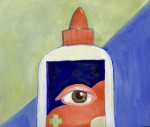UCLA researchers developed a gel that can heal wounded eyeballs.
The adhesive gel, when applied to injuries on the cornea, the outermost layer of the eye, promotes the growth of surrounding cells and seals any cuts. The researchers’ study was published March 20 in Science Advances.
Nasim Annabi, a chemical and biomolecular engineering assistant professor in the UCLA Samueli School of Engineering and the study’s co-principal investigator, said she decided to investigate corneal healing when she spoke with a Harvard ophthalmologist about the difficulties of sealing wounds after a corneal transplant.
“What they use in the clinic is very bad for the patients, so she asked if we could design a new material that can adhere to the cornea and be easily applied to seal any injury,” Annabi said.
Sophie Deng, a professor in the cornea division at the UCLA Stein Eye Institute, said a corneal transplant patient’s recovery rate depends on the person and their respective surgery.
“As soon as in one week, some patients can achieve 20/20 vision,” Deng said. “For the other types (of surgery), it really depends on the shape of the cornea, and it takes six months to one year for the cornea wound to stabilize.”
Deng added patients who undergo more intensive surgery often need contact lenses or glasses for an extended period of time.
Ali Khademhosseini, a bioengineering professor and an author of the study, said the gel was made from natural materials to close corneal incisions effectively without delaying the healing process.
“If you’re putting materials in (the wound) that the body doesn’t do well with, then the healing does take longer,” Khademhosseini said. “Sometimes when you want to close a hole, you do have to really try to make materials that are biocompatible.”
Khademhosseini said the material was a modified form of gelatin, which is commonly found in human tissue, that transforms from a liquid to a gel in the presence of light.
“It was modified in a way that you can shine light onto the material and turn it from something that is liquid-y and turn it into a gel,” Khademhosseini said. “Then we can put that onto the wound and then it can plug the hole and because cells like to interact with gelatin, that all works in a way that allows you to use this glue to heal the injury.”
Khademhosseini said researchers first apply the liquid material to the cornea, then shine light through a special lens to turn it into a gel and begin the healing process. Khademhosseini added the material increases the cornea’s rate of recovery.
“(The gel) can get on the incision, and because it’s made from natural materials, then it can not only fix the incision but also induce regeneration better,” Khademhosseini said.
Annabi said, in the future, doctors could use the gel in tandem with drugs to combat additional infections while the cornea recovers from injury.
“When you have a laceration, infection is one of the problems,” Annabi said. “We can use this gel as a platform and load it with different types of drugs or medication to treat different types of diseases.”
Khademhosseini said the material was tested on rabbits and proved to be more effective at healing the cornea than traditional treatments.
Annabi said she plans to test the material on live animals for an extended period of six months to a year to better understand the impact of the gel.
Deng said she is hopeful to see how there are developments in her field aimed at improving patient recovery rates.
“As a corneal surgeon, I would love to see anything new that will help with healing,” Deng said. “I am very excited that a UCLA researcher is interested in corneal wound healing.”
